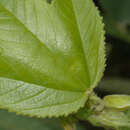ar
الأسماء في صفحات التنقل


Passiflora mixta (lat. Passiflora mixta) - qonaqotukimilər fəsiləsinin qonaqotu cinsinə aid bitki növü.
Passiflora mixta (lat. Passiflora mixta) - qonaqotukimilər fəsiləsinin qonaqotu cinsinə aid bitki növü.
Passiflora mixta, from the family Passifloraceae is also known as curuba, curuba de indio, curuba de monte, curubita, curuba (Colombia), parcha (Venezuela), and taxo (Ecuador). Originally, it derived from the monophyletic Passiflora subgenus Tacsonia. Passiflora mixta is endemic to the Americas. A perennial vine, the Passiflora mixta is pink to orange-red in color.[1]

Passiflora mixta can be identified by large pink flowers, trilobate coricaeous leaves, that are tubular in shape that protrude from its branches. It has a hairy elongated bract and hypanthum that contain a narrow nectar chamber. At 7–15 cm long (2.8–5.9 in), Passiflora mixta has a hypanthium (otherwise known as the flower tube) with a base that contains nectar. Also found in P. mixta, are ovaries, anthers and stigmas. These reproductive organs are located anterior to the hypanthium near the androgynophore. This species is capable of producing fruits and flowers that remain open for 3 to 5 days by producing half-pendant, horizontal, or erect flowers.
Status: Wild plant, collected, important genetic resource for banana passionfruit breeding. [2]
This species of Passiflora is pollinated by the Sword-billed hummingbird (Ensifera ensifera), which is the only living species in the genus Ensifera. This bird is found throughout the northern Andes and is identified by its extremely large beak that is longer than the size of its entire body. They are pollinators of the passionflower, which contains nectar at the bottom of the long corolla tube that belongs to the P. mixta. [4]
Passiflora mixta, from the family Passifloraceae is also known as curuba, curuba de indio, curuba de monte, curubita, curuba (Colombia), parcha (Venezuela), and taxo (Ecuador). Originally, it derived from the monophyletic Passiflora subgenus Tacsonia. Passiflora mixta is endemic to the Americas. A perennial vine, the Passiflora mixta is pink to orange-red in color.
Passiflora mixta je biljka iz porodice Passifloraceae. Imena su joj u Kolumbiji curuba, curuba de indio, curuba de monte, curubita, palta, u Venezueli parcha te u Ekvadoru tacso. Izvorno je izvedena od monofiletske Passiflora subgenus Tocsonia. Passiflora mixta raste po Južnoj Americi. Boje je od ružičaste do narančastocrvene.[1]
Passiflora mixta je biljka iz porodice Passifloraceae. Imena su joj u Kolumbiji curuba, curuba de indio, curuba de monte, curubita, palta, u Venezueli parcha te u Ekvadoru tacso. Izvorno je izvedena od monofiletske Passiflora subgenus Tocsonia. Passiflora mixta raste po Južnoj Americi. Boje je od ružičaste do narančastocrvene.
Passiflora mixta L.f. – gatunek rośliny z rodziny męczennicowatych (Passifloraceae Juss. ex Kunth in Humb.). Występuje naturalnie w Wenezueli, Kolumbii, Ekwadorze, Peru oraz Boliwii[3], gdzie rośnie na wyżynach na wysokości 1700–3700 (–4000) m n.p.m.[4]
Snow i Snow (1980) zasugerowali, że kwiaty P. mixta koewoluowały razem z dziobem kolibra mieczodziobka (Ensifera ensifera), zważywszy na długie kwiaty zapylanej przez kolibra męczennicy i bardzo długi dziób mieczodziobka; do tego ich zasięgi w większości pokrywają się[4].
Passiflora mixta L.f. – gatunek rośliny z rodziny męczennicowatych (Passifloraceae Juss. ex Kunth in Humb.). Występuje naturalnie w Wenezueli, Kolumbii, Ekwadorze, Peru oraz Boliwii, gdzie rośnie na wyżynach na wysokości 1700–3700 (–4000) m n.p.m.
Snow i Snow (1980) zasugerowali, że kwiaty P. mixta koewoluowały razem z dziobem kolibra mieczodziobka (Ensifera ensifera), zważywszy na długie kwiaty zapylanej przez kolibra męczennicy i bardzo długi dziób mieczodziobka; do tego ich zasięgi w większości pokrywają się.
Passiflora mixta là một loài thực vật có hoa trong họ Lạc tiên. Loài này được L.f. mô tả khoa học đầu tiên năm 1782.[1]
Passiflora mixta là một loài thực vật có hoa trong họ Lạc tiên. Loài này được L.f. mô tả khoa học đầu tiên năm 1782.